Mehr als 10 Brücken führen in Budapest mittlerweile über die Donau. Von historischen Architekturdenkmälern bis zu modernen Autobahnbrücken stellen sie ein unverkennbares Wahrzeichen von Ungarns Hauptstadt dar.
Vor ihrer Mündung ins Schwarze Meer ist Budapest die letzte Stadt, die sich über beide Ufer der Donau erstreckt. Seit dem frühen 19. Jahrhundert entstanden insgesamt 11 Donaubrücken, die diese beiden Ufer bzw. die Stadtteile Buda und Pest miteinander verbinden. Die teils altehrwürdigen Meisterwerke der Ingenieurskunst zählen zu unseren Top 10 Sehenswürdigkeiten von Budapest.
Inhaltsverzeichnis
Kettenbrücke
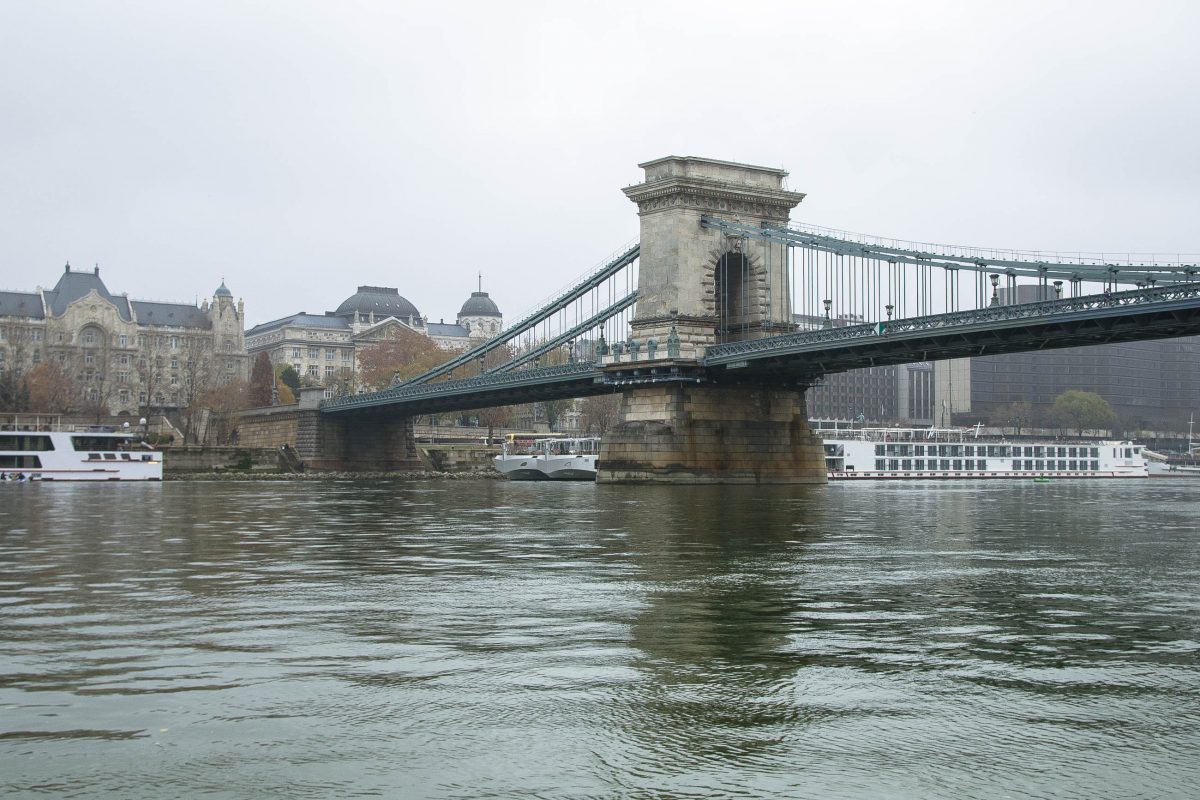
Die eindrucksvolle Kettenbrücke in Budapest, die eigentlich „Széchenyi Lánchíd“ heißt, ist ein wichtiges Symbol der ungarischen Hauptstadt. Sie war die erste feste Brücke über die Donau, die die beiden Städte Buda und Pest miteinander verband.
Entstehung der Kettenbrücke
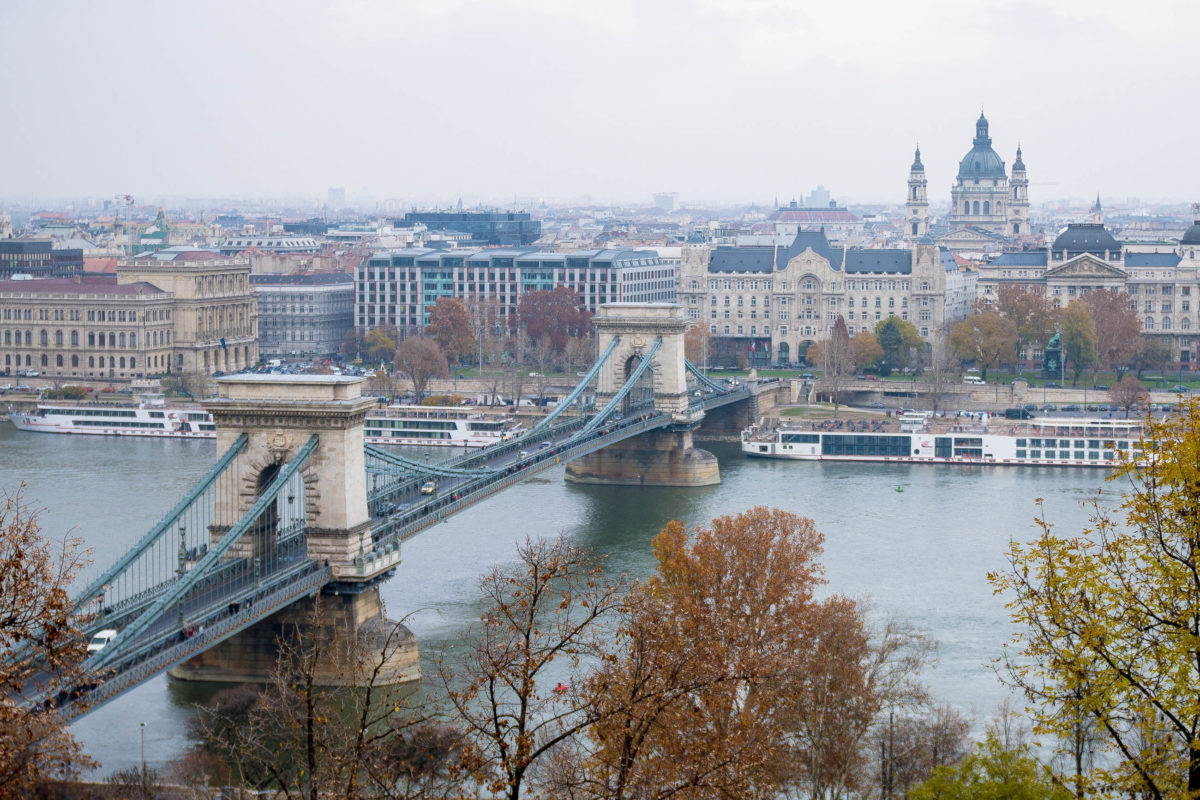
Im Jahr 1839 begann der Brückenbau auf Vorschlag des ungarischen Reformers und Präsident des Budapester Verkehrskommitees Graf István Széchenyi, nach dem die Brücke auch benannt wurde. Früher konnten die damals noch unabhängigen Stadtteile nämlich nur über eine Schwimmbrücke erreicht werden. Diese war aus Holz und hielt dem auf der Donau driftenden Eis nicht stand, weshalb sie im Winter abgebaut werden musste. 10 Jahre später wurde sie fertiggestellt und war damals die erste Donaubrücke unterhalb der Regensburger Steinernen Brücke.
Die Kettenbrücke misst eine Länge von 375m und verbindet den Széchenyi-István-Platz in der Innenstadt von Pest mit dem Adam-Clark-Platz vor dem Burgberg in Buda, der nach dem Bauleiter der Kettenbrücke, einem britischen Ingenieur benannt wurde.
Der Name „Kettenbrücke“ hat sich deshalb durchgesetzt, da die eindrucksvolle Hängebrücke von gigantischen Ketten gehalten wird, die an zwei Stützpfeilern verankert sind, die über 202 Meter auseinander liegen – ein Meisterwerk der Brückenbaukunst in der damaligen Zeit, das in der Ingenieurswelt internationale Bewunderung erfuhr.
Kettenbrücke: Wahrzeichen von Budapest
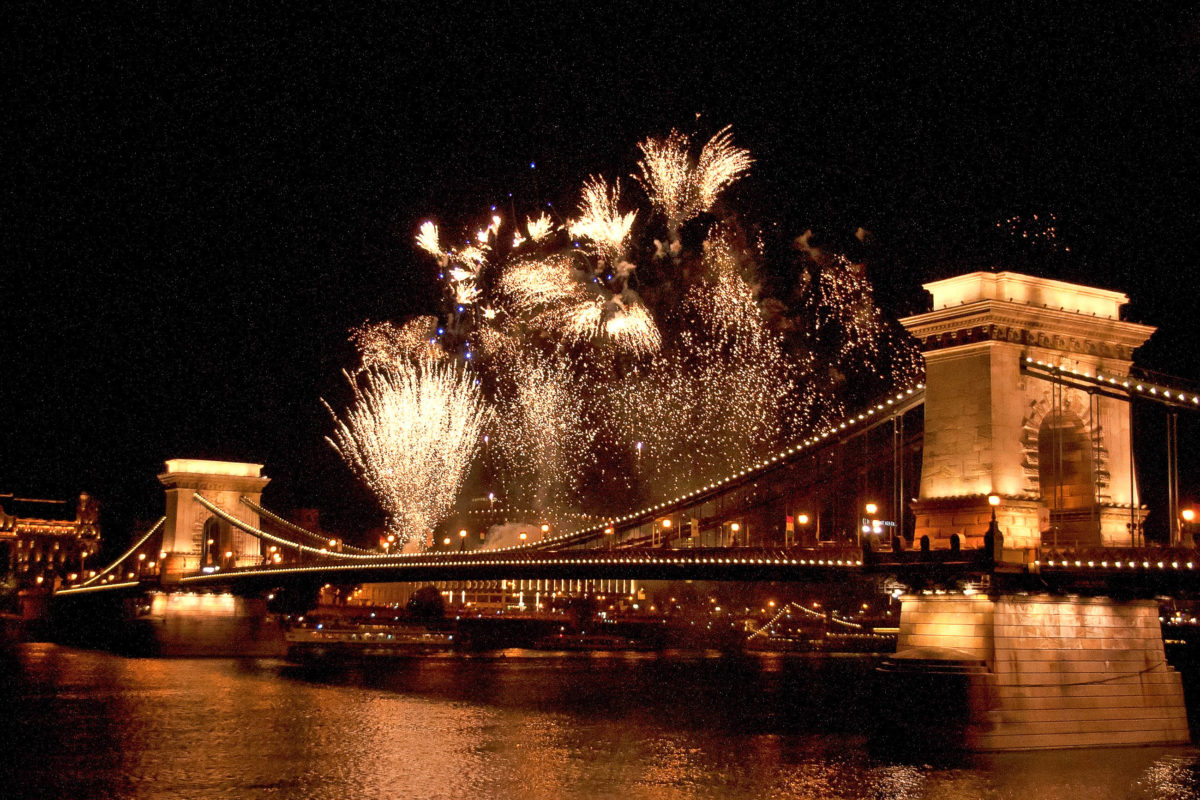
Die Brücke ist knapp 7 Meter breit und führt sowohl den Autoverkehr als auch Fußgänger sicher über die Donau von Buda nach Pest und umgekehrt. Beide Enden der Brücke werden von zwei gewaltigen Löwenstatuen flankiert. Angeblich soll der Bildhauer dieser Wächterlöwen, Marschalko János, Selbstmord begangen haben, nachdem er erst bei der Eröffnung festgestellt hatte, dass er seine majestätischen Kunstwerke ohne Zungen modelliert hatte.
Die klassizistischen Stützpfeiler sind ebenfalls prunkvoll verziert und erinnern durch ihre Form an Triumphbögen.
Im Jahr 1915 wurde das Verkehrsaufkommen in Budapest immer stärker und die ursprüngliche Brücke wurde durch eine 5.000 Tonnen schwere Stahlkonstruktion verstärkt. Was an der Kettenbrücke noch aus Holz war, wurde nun durch Eisen ersetzt. 1949 wurde die Kettenbrücke zum dritten Mal wieder eröffnet, nachdem sie im Zweiten Weltkrieg den Sprengkommandos der Deutschen zum Opfer gefallen war – genau zum 100. Jahrestag der ersten Brückeneinweihung.
Der 150. Jahrestag der Brücke wurde mit einer neuen spektakulären Beleuchtung gefeiert. Vor allem des nachts bietet sie einen romantischen Anblick und ist ein ebenso prachtvolles wie beliebtes Fotomotiv.
Margaretenbrücke
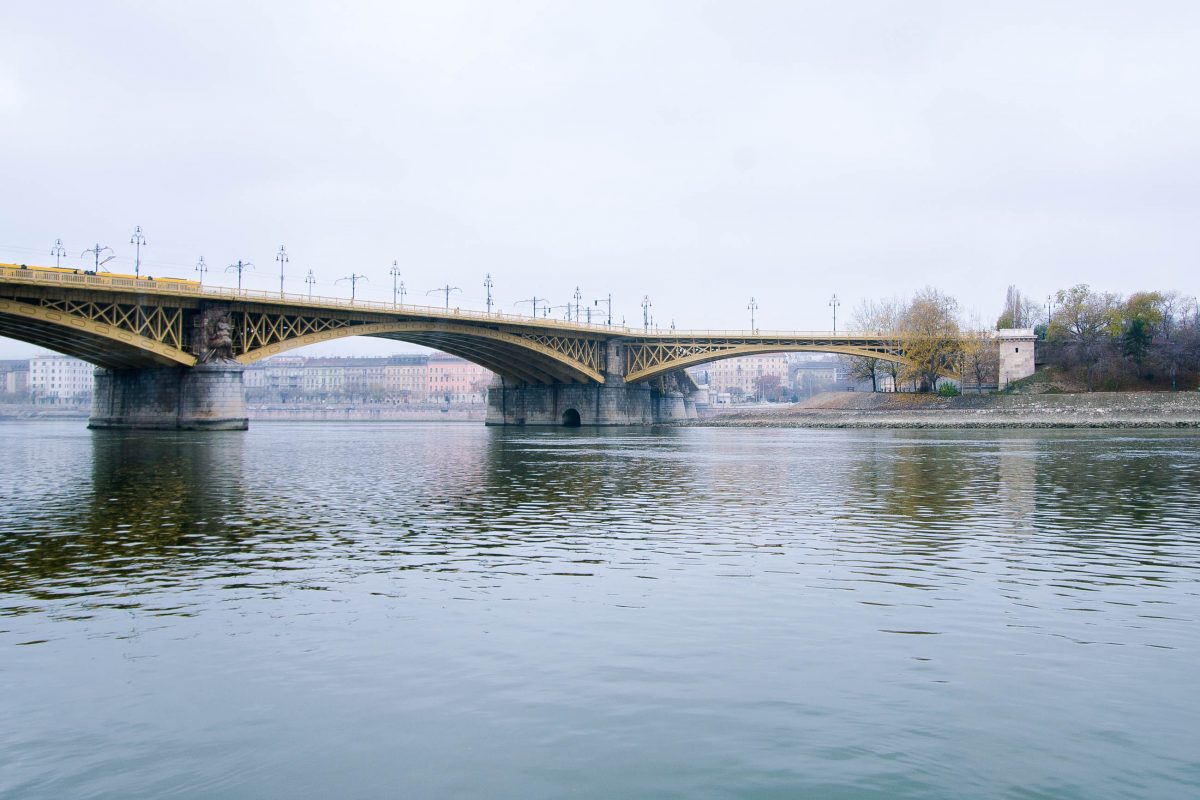
Die Margaretenbrücke wurde nach der Kettenbrücke als zweite der neun Autobrücken errichtet und bietet einen herrlichen Blick auf Budapest und seine Sehenswürdigkeiten. Geradeaus führt die Kettenbrücke mit ihren Triumphbögen über die Donau, auf der Pester-Seite thront das imposante Parlamentsgebäude mit seinen unzähligen Türmchen und auf der Budaer Seite der Burgpalast und die Matthias-Kirche. Alle vier Baudenkmäler sind in der Nacht herrlich beleuchtet.
Entstehung der Margaretenbrücke
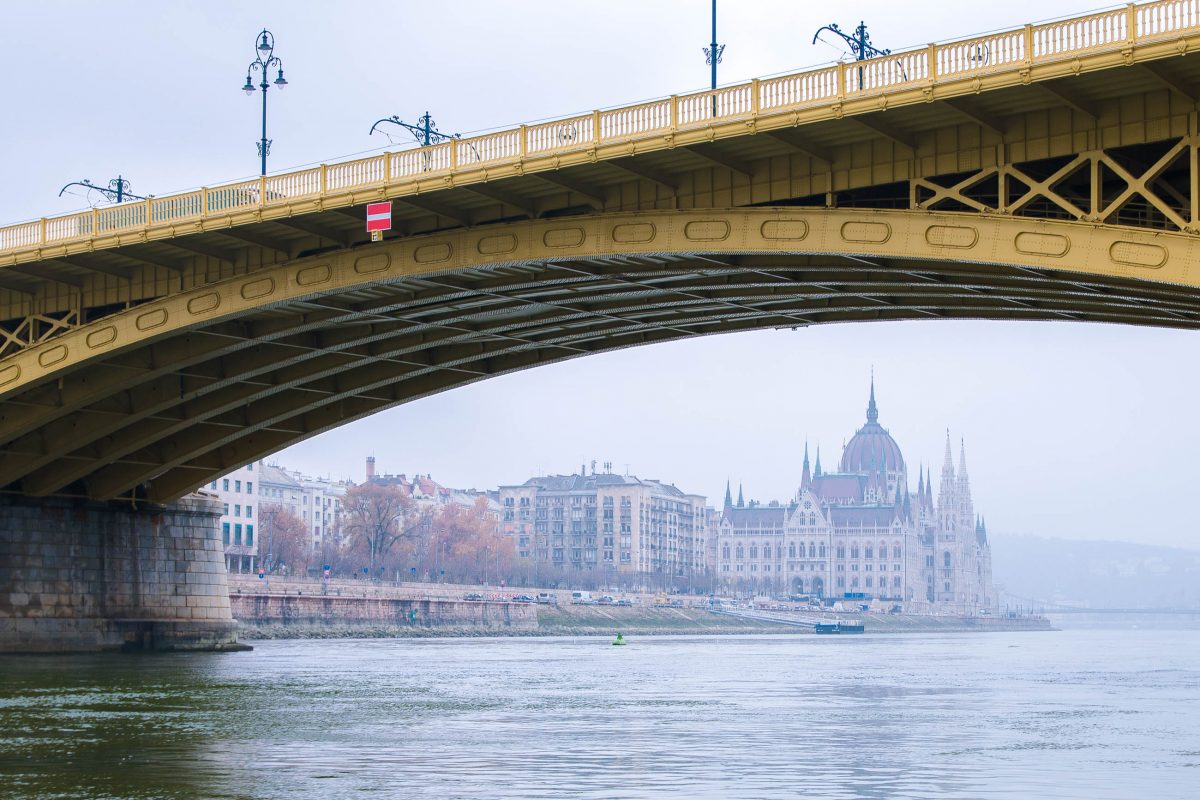
Die Brücke hat ihren Namen von der Margareteninsel, über deren Südspitze sie führt. Die Insel wiederum wurde nach Margarete, der Tochter des ungarischen Königs Béla IV., benannt, die seit ihrem neunten Geburtstag in einem Dominikaner-Kloster auf der Insel lebte. Der König hielt somit sein Versprechen, nach dem Sieg über die einfallenden Mongolen ein Kloster zu gründen und seine Tochter zur Nonne zu machen.
Architekt und Bauleiter der Brücke war der französische Ingenieur Ernest Goüin. Die Margaretenbrücke wurde im Jahr 1876 nach vier Jahren Bauzeit fertiggestellt, die abzweigende Flügelbrücke zur Margareteninsel wurde allerdings erst im Jahr 1900 eingebaut. Zuvor war die Insel nur per Boot erreichbar gewesen.
Die 600m lange Brücke ist sieben trutzigen Strompfeilern in der Donau verankert. Sie fällt vor allem durch ihre Sandsteinfiguren an den Brückenpfeilern auf, die am besten auf einer Schifffahrt auf der Donau betrachtet werden können. Ebenfalls einen prachtvollen Anblick bietet sie vom Budaer Burgberg, wenn sie gemeinsam mit den anderen Donaubrücken der Stadt wunderbar beleuchtet ist.
Sprengung im Zweiten Weltkrieg
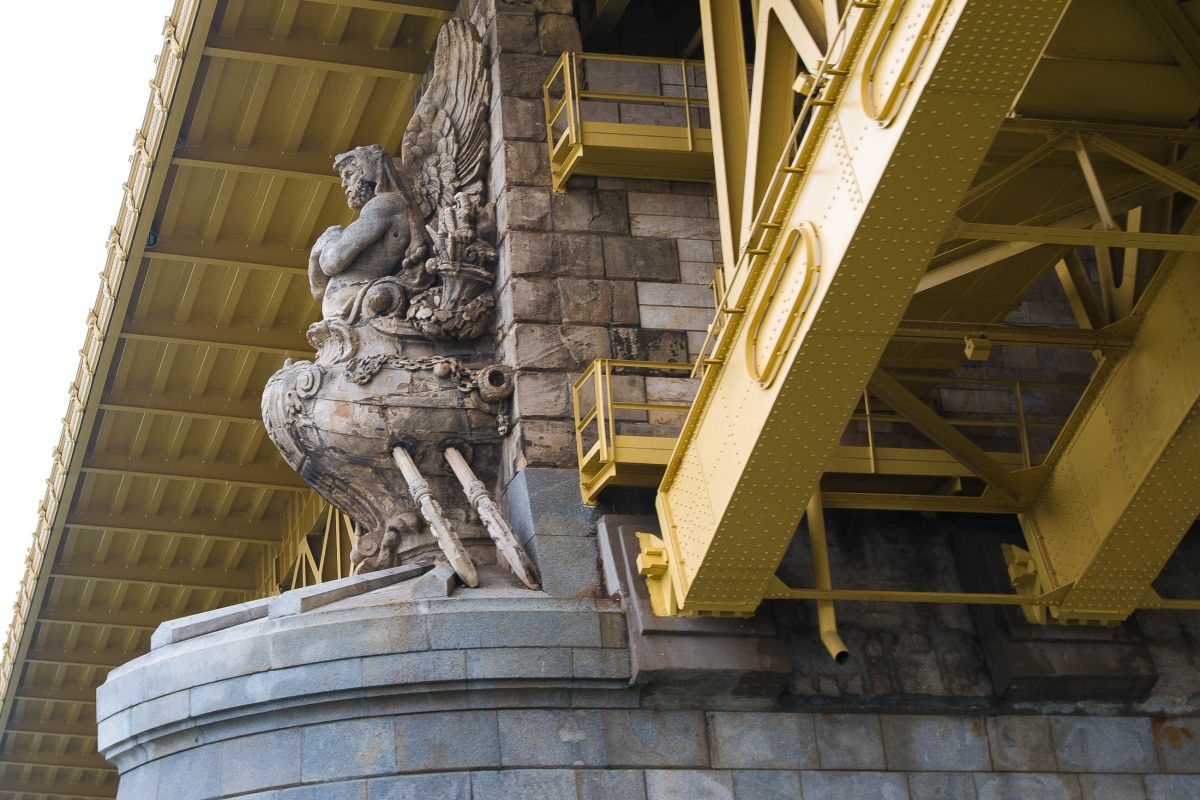
Vom deutschen Sprengkommando, dem alle Budapester Donaubrücken zum Opfer fielen, wurde die Margaretenbrücke sogar zweimal gesprengt. Das erste Mal, im November 1944, wurde der Zündsatz zu Übungszwecken scharf gemacht und die Zündschnur durch Zufall von einem durchfahrenden Schiff entzündet, was zwei Bögen zum Einsturz brachte. Damals befanden sich noch etwa 800 Personen auf der Brücke, von denen schätzungsweise 600 ums Leben kamen. Die absichtliche und vollständige Sprengung der Margaretenbrücke erfolgte dann im Jänner 1945 beim Rückzug der Deutschen Wehrmacht aus Budapest.
Allerdings ließ der Wiederaufbau nicht lange auf sich warten. Bereits im August 1948 waren die zweijährigen Bauarbeiten abgeschlossen und die Margaretenbrücke konnte neuerlich eröffnet werden. Die letzte Renovierung wurde 2011 abgeschlossen.
Freiheitsbrücke
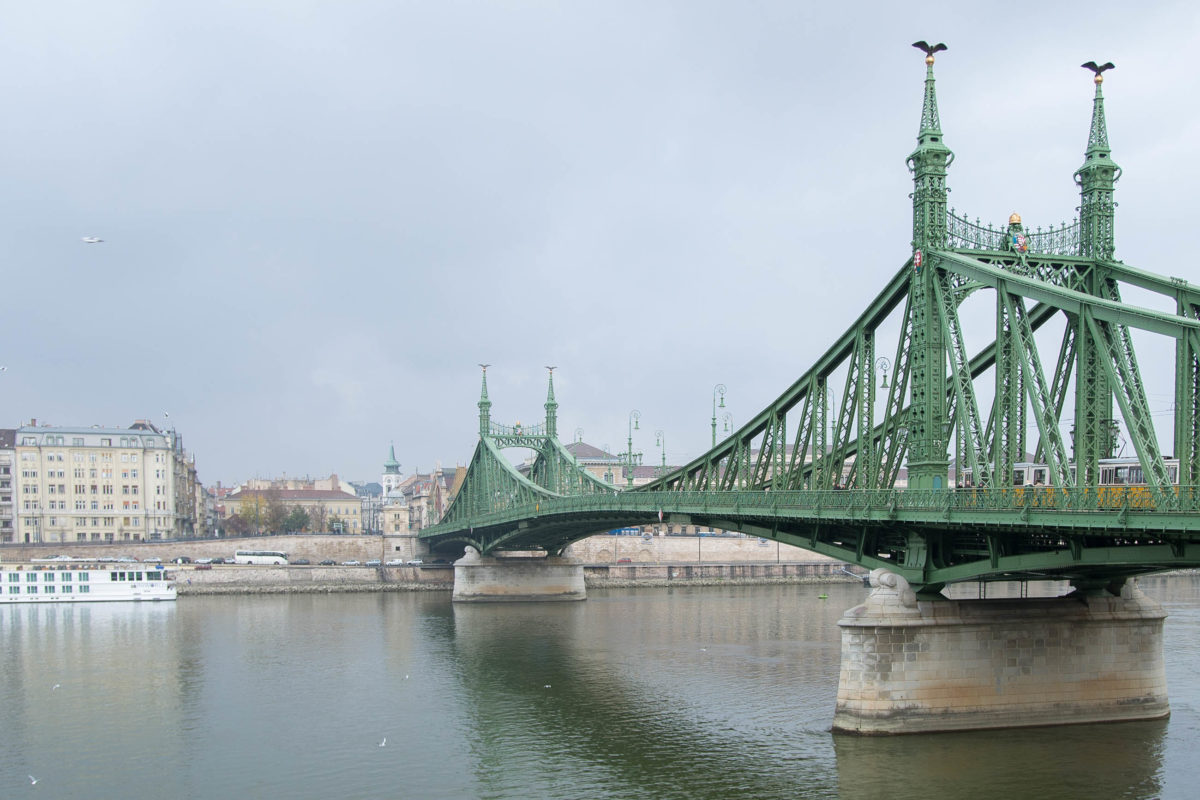
Die Szabadság híd war nach der Kettenbrücke und der Margaretenbrücke die dritte Donaubrücke, die in Budapest errichtet wurde. Sie führt am Fuß des Gellért-Berges vom Platz Szent Gellért tér zum Kleinen Ring im Stadtteil Pest.
Entstehung der Freiheitsbrücke
Die Bauleitung hatte der ungarische Ingenieur János Feketeházy inne. Die Freiheitsbrücke wurde am 4. Oktober 1896 nach zweijähriger Bauzeit zum 1.000. Jahrestag der Landnahme eröffnet.
Ursprünglich hieß die Freiheitsbrücke Franz-Joseph-Brücke, nach dem amtierenden ungarischen Kaiser Franz Joseph I. An diesen erinnern immer noch die Initialen FJI am Pester Brückenkopf. Den letzten – silbernen – Nagel schlug der Kaiser symbolisch höchstpersönlich ein. Dieser Nagel ist übrigens bis heute erhalten. Nachdem er allerdings im Jahr 1956 entwendet wurde, befindet er sich heute geschützt unter Glas.
Wiederaufbau als Freiheitsbrücke
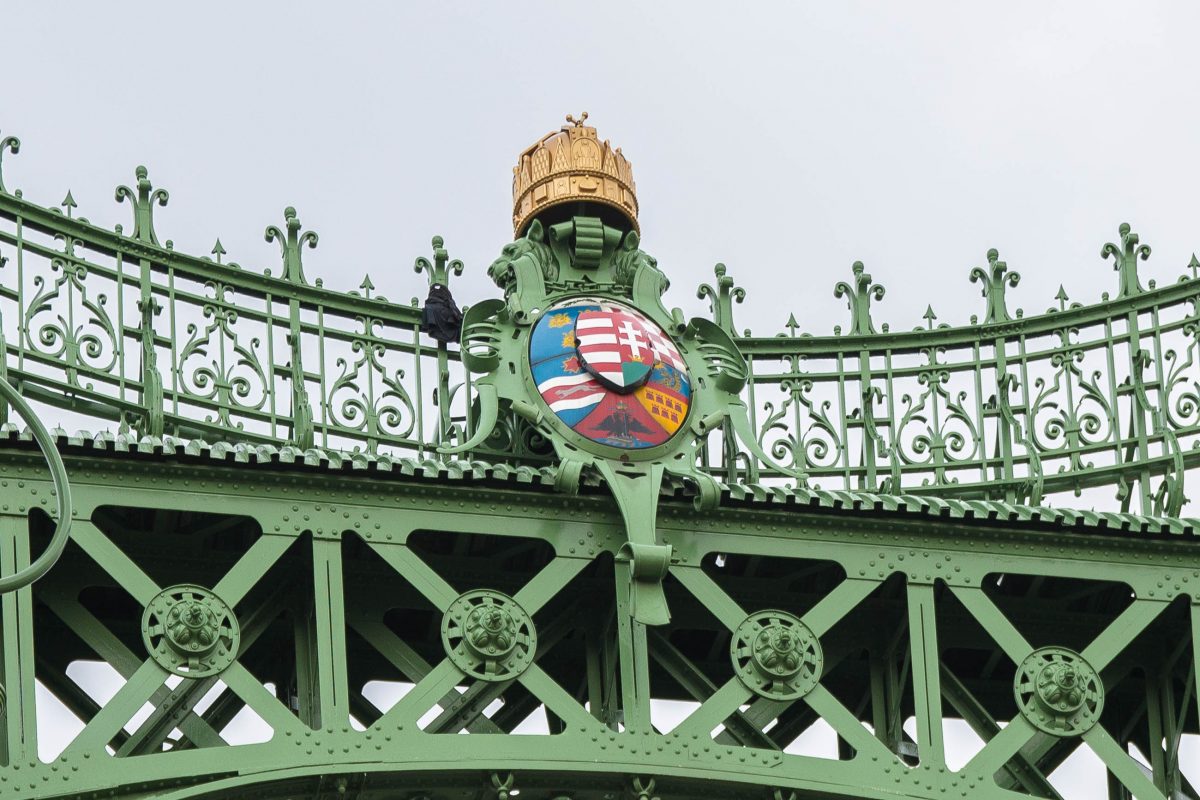
Während des Zweiten Weltkriegs wurde die Franz-Joseph-Brücke im Jahr 1945 beim Rückzug der Deutschen wie alle anderen Donaubrücken gesprengt. Der Schaden an dieser Brücke war allerdings verhältnismäßig gering, sodass sie originalgetreu wiederhergestellt und nur eineinhalb Jahre später, am 20. August 1946 als erste der zerstörten Brücken wieder eröffnet werden konnte – diesmal unter dem heutigen Namen Freiheitsbrücke.
Sogar die originalen Ornamente, das Königswappen und die Turul-Vögel blieben erhalten und konnten bei der Rekonstruierung verwendet werden. Letztere sind mythische Vögel aus Ungarns Geschichte und sitzen zu viert mit ausgebreiteten Schwingen auf goldenen Kugeln über den Brückenpfeilern. Auch auf einem Pfeiler im Burgpalast ist ein derartiger Fabelvogel zu bewundern.
Elisabeth-Brücke
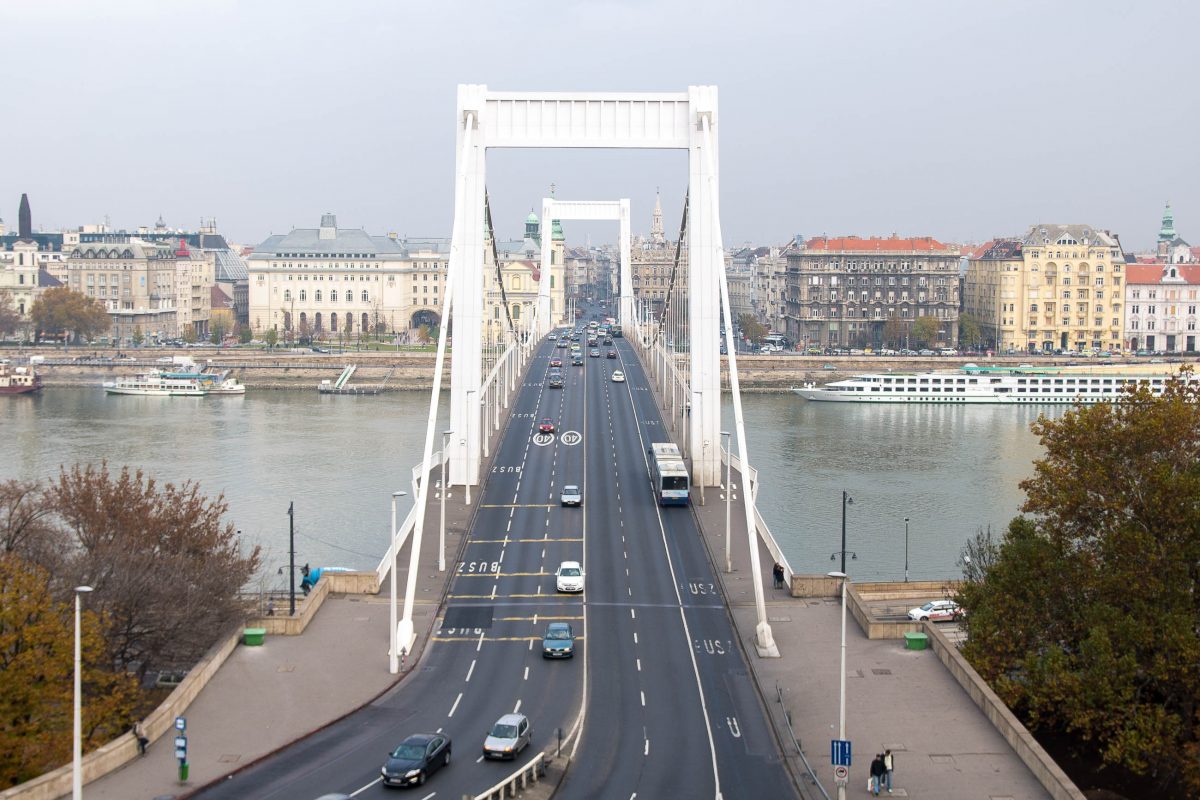
Die schneeweiße Elisabeth-Brücke war die vierte von Budapests Donaubrücken. Sie führt vom Platz des 15. März in den Stadtteil Buda, wo sie zwischen dem berühmten Burgberg mit dem Burgpalast, der Fischerbastei und der Matthiaskirche, und dem Gellértberg mündet. Ihre Namensgeberin war die österreichische Kaiserin Elisabeth I., besser bekannt als Sisi, die auch zur Königin Ungarns gekrönt wurde.
Die Elisabeth-Brücke fällt durch ihre filigran anmutende Eleganz und ihre moderne Architektur auf. Zwischen zwei hohen, schneeweißen Toren an beiden Ufern der Donau tragen 61 Stahlseile aus je 115 Drähten die leicht nach oben gebogene Fahrbahn, die mit einer Länge von 380m 290m über die Donau führt. Die Brücke ist insgesamt knapp 30m breit und umfasst 6 Fahrspuren und zwei gut 4m breite Gehwege.
Entstehung der Elisabeth-Brücke
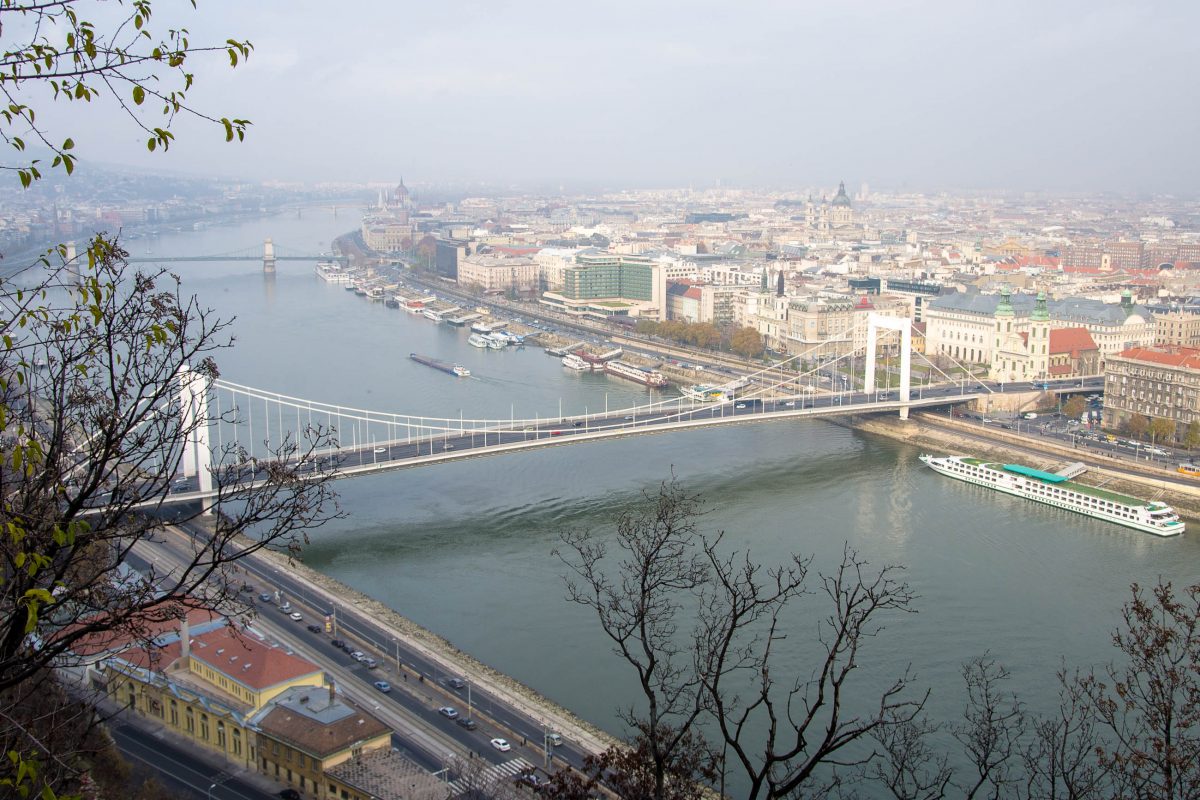
Ursprünglich sollte die Elisabeth-Brücke eine Hängebrücke werden, allerdings ließ sich in Ungarn kein geeignetes Material für die Drahtseile finden. So entschloss man sich für die Konstruktion einer Kettenbrücke, ähnlich der benachbarten Kettenbrücke, die 1849 fertiggestellt worden war. Nach einem Wettbewerb, in dem 53 Entwürfe eingereicht wurden, startete der Bau im Jahr 1897.
Am 10. Oktober 1903 konnte die Elisabeth-Brücke eingeweiht werden, 5 Jahre nach der Ermordung von Kaiserin Sisi. Damals war die Elisabeth-Brücke genauso lang wie heute, allerdings nur knapp 18 Meter breit und bot einer vierspurigen Fahrbahn und zwei je gut 3m breiten Gehwegen Platz.
Im Zweiten Weltkrieg wurde auch die Elisabeth-Brücke beim Rückzug der Deutschen im Jahr 1945 gesprengt. Sie war jedoch die einzige, die nach dem Krieg nicht wieder originalgetreu aufgebaut wurde, da sie erstens nicht hundertprozentig rekonstruiert werden konnte, zweitens die Kosten der neuen Brücke um ein Vielfaches höher gewesen wären und sie drittens dem anfallenden Verkehrsaufkommen nicht mehr standgehalten hätte.
Der Bau der zweiten Elisabeth-Brücke begann allerdings erst im Jahr 1959. 1964 wurde die schneeweiße Konstruktion für den Verkehr freigegeben. Seitdem gilt die Elisabethbrücke als Symbol des gelungenen Wiederaufbaus von Budapest nach dem Zweiten Weltkrieg.
Megyeri-Brücke
Die 1862m lange Megyeri híd ist die längste Donaubrücke von Budapest und die zweitlängste Brücke Ungarns. Sie wurde hauptsächlich zur Entlastung der Árpádbrücke erbaut, die als zweite Brücke über die Margareteninsel führt. 2008 vollendet ist sie die erste Schrägseilbrücke, die in Ungarn erbaut wurde. Ihre imposanten, 100m hohen A-Pylone machen die Megyeri-Brücke schon von weitem unverkennbar.
Rákóczi-Brücke
Ebenfalls unverkennbar ist die Rákóczi-Brücke. Sie wurde zur Entlastung der 1952 wiedereröffneten Petőfibrücke erbaut und 1995 fertiggestellt. Der Termin wurde aufgrund der Weltausstellung Expo 95 in Wien und Budapest gewählt, die jedoch nicht realisiert wurde. Ihre 35m hohen Mastpylone wirken wie riesenhafte Straßenlaternen, vor allem wenn sie die Rákóczi-Brücke in der Nacht in helles Licht tauchen.
Südliche Eisenbahnbrücke
Gleich südlich der Rákóczi-Brücke befindet sich mit der Südlichen Eisenbahnbrücke die erste und verkehrsreichste Eisenbahnbrücke von Budapest. Die ursprüngliche Brücke wurde von 1873 bis 1877 errichtet. 1910 entstand direkt daneben eine stabilere Brücke aus Stahl, die den immer größeren und schwereren Loks gewachsen war. Die heutige Südliche Eisenbahnbrücke wurde im Juni 1953 vollendet. 2008 wurden bei ihrem Pendant – der ursprünglich 1896 eröffneten Nördliche Eisenbahnbrücke – die Überbauten vollständig erneuert.





